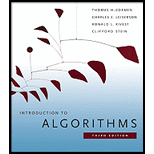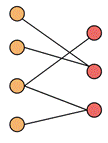
To show that any tree is 2-colorable.
Explanation of Solution
Given Information:
A  of an undirected graph
of an undirected graph  is a function
is a function  such that
such that  for every edge
for every edge 
Explanation:
There are no loops in tree, if a color (0) is given to a node, then all its neighbors should be colored with a different color say color (1). Now color the neighbors of all these neighbors with color (0). In this way keep coloring alternating colors until the whole tree is colored. Since there are no loops no node will be visited and thus colored twice. In the end any path in the tree has vertices with alternating colors.
To show that the following are equivalent:
- G is bipartite.
- G is 2-colorable.
- G has no cycles of odd length.
Explanation of Solution
A bipartite graph has two sets of vertices which has equal number of vertices in those two sets. So, if the given graph G is bipartite that means it will be 2 colorable because one set of vertices can be colored with one color say color (0) and another set of vertices can be colored with another set of vertices say color (1).
The following figure shows the bipartite graph with chromatic number

Also, it can be seen that it has no cycles of odd length from the above figure of bipartite graph.
So, on the basis of above illustration- the following points can be made-
- G is bipartite.
- G is 2-colorable.
- G has no cycles of odd length.
To prove that a Graph can be colored with  colors where
colors where  is the maximum degree of any vertex in graph.
is the maximum degree of any vertex in graph.
Explanation of Solution
Greedy coloring procedure requires us to number the colorsthat are used. So, each time a new color is introduced it is numbered.
Greedy coloring
If the maximum degree vertex of a graph has degree d, let this vertex be v.
Color v with color 1.
Since all the adjacent vertices of 'v' have to be colored with a color other than color of 'v', let us assume that all the adjacent vertices are colored with different colors.
As number of neighbors is d, hence number of additional colors required is d. So, maximum d+1 colors are needed.
This is the maximum number of colors needed because in no case there will be more than d+1 colorsas the maximum degree is d. (All the neighbors and other nodes of graph have degree <= d)
Proof by mathematical induction:
Base case: A graph with just 1 vertex has maximum degree 0 and needs only 1 color. It is 1-colorable.
Inductive hypothesis: It can be assumed that any graph which has = k vertices and maximum vertex degree = d can be colored with d+1 colors.
Inductive Step: Now suppose there is a graph G with k+1 vertices and maximum degree d. Remove a vertex v (and all its edges) from G to create a smaller graph G'.
The maximum degree of G' is not greater than d, because removing a vertex from G' won't increase its degree. So, by the inductive hypothesis, G' can be colored with d + 1 colors. The neighbors of v are only using d of the available colors because v has maximum d neighbors, leaving a spare color that can be assigned to v.
Therefore, the coloring of G is an extension of coloring of G'. Hence, G can be colored with d+1 colors. G is (d+1)-colorable.
To show that a graph G can be colored with  if it has
if it has  edges.
edges.
Explanation of Solution
Run the above greedy algorithm when a color is used for the first time, to color a vetex
is used for the first time, to color a vetex mark the edges joining
mark the edges joining  to vertices already coloured which is atleast
to vertices already coloured which is atleast
Every marked edge is marked only once during the process and at least  edges will be marked when number of colors are used. So if number of colors are present, then number of edges will be colored.
edges will be marked when number of colors are used. So if number of colors are present, then number of edges will be colored. 
Want to see more full solutions like this?
Chapter B Solutions
Introduction to Algorithms
- Ensure you answer the question asked at the end of the document. Do not just paste things without the GNS3 console outputsarrow_forward"Do not use AI tools. Solve the problem by hand on paper only and upload a photo of your handwritten solution."arrow_forward"Do not use AI tools. Solve the problem by hand on paper only and upload a photo of your handwritten solution."arrow_forward
- "Do not use AI tools. Solve the problem by hand on paper only and upload a photo of your handwritten solution."arrow_forward"Do not use AI tools. Solve the problem by hand on paper only and upload a photo of your handwritten solution."arrow_forwardSolve this "Do not use AI tools. Solve the problem by hand on paper only and upload a photo of your handwritten solution."arrow_forward
- "Do not use AI tools. Solve the problem by hand on paper only and upload a photo of your handwritten solution."arrow_forward"Do not use AI tools. Solve the problem by hand on paper only and upload a photo of your handwritten solution."arrow_forwardSpecifications: Part-1Part-1: DescriptionIn this part of the lab you will build a single operation ALU. This ALU will implement a bitwise left rotation. Forthis lab assignment you are not allowed to use Digital's Arithmetic components.IF YOU ARE FOUND USING THEM, YOU WILL RECEIVE A ZERO FOR LAB2!The ALU you will be implementing consists of two 4-bit inputs (named inA and inB) and one 4-bit output (named out). Your ALU must rotate the bits in inA by the amount given by inB (i.e. 0-15).Part-1: User InterfaceYou are provided an interface file lab2_part1.dig; start Part-1 from this file.NOTE: You are not permitted to edit the content inside the dotted lines rectangle. Part-1: ExampleIn the figure above, the input values that we have selected to test are inA = {inA_3, inA_2, inA_1, inA_0} = {0, 1, 0,0} and inB = {inB_3, inB_2, inB_1, inB_0} = {0, 0, 1, 0}. Therefore, we must rotate the bus 0100 bitwise left by00102, or 2 in base 10, to get {0, 0, 0, 1}. Please note that a rotation left is…arrow_forward
 Operations Research : Applications and AlgorithmsComputer ScienceISBN:9780534380588Author:Wayne L. WinstonPublisher:Brooks Cole
Operations Research : Applications and AlgorithmsComputer ScienceISBN:9780534380588Author:Wayne L. WinstonPublisher:Brooks Cole Fundamentals of Information SystemsComputer ScienceISBN:9781305082168Author:Ralph Stair, George ReynoldsPublisher:Cengage Learning
Fundamentals of Information SystemsComputer ScienceISBN:9781305082168Author:Ralph Stair, George ReynoldsPublisher:Cengage Learning C++ Programming: From Problem Analysis to Program...Computer ScienceISBN:9781337102087Author:D. S. MalikPublisher:Cengage Learning
C++ Programming: From Problem Analysis to Program...Computer ScienceISBN:9781337102087Author:D. S. MalikPublisher:Cengage Learning Principles of Information Systems (MindTap Course...Computer ScienceISBN:9781285867168Author:Ralph Stair, George ReynoldsPublisher:Cengage Learning
Principles of Information Systems (MindTap Course...Computer ScienceISBN:9781285867168Author:Ralph Stair, George ReynoldsPublisher:Cengage Learning New Perspectives on HTML5, CSS3, and JavaScriptComputer ScienceISBN:9781305503922Author:Patrick M. CareyPublisher:Cengage Learning
New Perspectives on HTML5, CSS3, and JavaScriptComputer ScienceISBN:9781305503922Author:Patrick M. CareyPublisher:Cengage Learning





